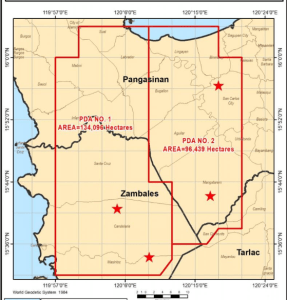
With the global shift toward cleaner energy, alternative energy sources like hydrogen are gaining more attention. And blessed are the nations that have untapped natural hydrogen reserves, like the Philippines, as this is believed to be an infinite source of energy.
In the Philippines, almost the entire province Zambales and a large area of Pangasinan have been identified by the Department of Energy (DOE) to have untapped natural hydrogen, of which a big area is part of the Zambales Ophiolite Complex.
Google defines Ophiolites as “an assemblage of mafic and ultramafic lavas and hypabyssal rocks found in association with sedimentary rocks like greywackes and cherts.” Ophiolite complexes are believed to have natural hydrogen.
A map from the Department of Energy showed that the pre-determined areas (PDAs) for hydrogen exploration covers a total of 230,535 hectares, which the DOE is offering in two separates PDAs of 134,096 hectares and 96,439 hectares.
THE DOE said that the exploration of natural hydrogen in the PDAs identified in Pangasinan and Zambales is being bidded out and has generated interest among local and foreign energy exploration firms. Foreign firms can have a 100-percent participation in the exploration activities.
IEA sees huge potential
For its part, the International Energy Agency (IEA) sees a huge potential for hydrogen utilization to produce clean energy.
“The number of announced projects for low-emission hydrogen production is rapidly expanding. Annual production of low-emission hydrogen could reach 38 MT (metric tons) in 2030, if all announced projects are realized, although 17 MT come from projects at early stages of development.
The IEA added that the potential hydrogen production by 2030 from projects that have been announced is 50-percent larger than what it projected in 2022 through the Global Hydrogen Review 2022.
However, much of hydrogen deployment based on the IEA’s projections are from hydrogen produced through various processes utilizing expensive equipment. On the other hand, natural hydrogen is formed by a natural process beneath the Earth that can seem to go on eternally, making it an almost infinite source of energy.
This means that natural hydrogen can present a more efficient source of energy compared to hydrogen that is produced through machines. And the exploration of natural hydrogen in Pangasinan and Zambales should get the Philippines excited, as scientists believe that the world’s largely untapped hydrogen reserves can provide clean energy for mankind for hundreds of years.
(DOE image show the hydrogen exploration areas in Zambales and Pangasinan)








